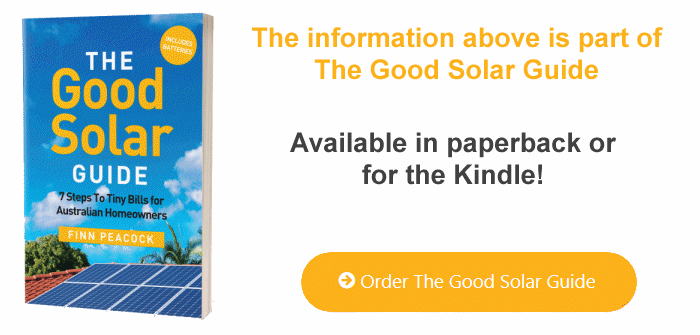Shifting loads
← Post-Installation | The Good Solar Guide Contents | Checking Your Bills →
Once your solar power system is installed and your retailer has reconfigured or replaced your meter, the system will be powered on and it will start generating electricity – hopefully, non-stop for 30 years (although you’ll need to replace the inverter after about 15 years).
If you want to maximise your savings, now is a great time to think about shifting loads to the daytime.
From now on, when you use an appliance before the sun is up or after the sun’s gone down, think about whether you could use it during the day instead.
Here are some examples to get you thinking.
Dishwasher: Morning
Do you get up in the morning, stack the dishwasher with breakfast plates, set it going and then leave the house?
Dishwashers can pull a couple of kW when they heat the water at the beginning of the cycle and again when they dry the dishes. (Anything that involves heating will use a lot of power.)
Your solar system’s power will be fairly limited until about 10am, so why not use the delay-start feature so your dishwasher doesn’t start until two hours after you leave the house?
Dishwasher: Evening
Whether you can pull off this trick depends on how big your dishwasher is compared with the size of your family. Is it possible to stack the dishwasher in the evening so you can still fit in the breakfast dishes? If yes, instead of running it overnight, you could wait until the morning and delay-start it.
Washing machine
Can you delay-start this in the morning? If possible, stagger it with the dishwasher – for example, put this on a four-hour delay and the dishwasher on a two-hour delay if you’re leaving the house.
Clothes dryer
A conventional dryer is one of the most power-hungry devices in your home. It can chew though 3–8 kWh in one cycle.
If you have to use it, the middle of the day is best – but if the sun is shining, why aren’t you sticking the washing on the line?
I would make it a priority to upgrade this appliance to a more efficient model. A six-star heat-pump dryer is up to four times more efficient than a regular dryer. In general, you’ll only use the dryer when the weather isn’t good enough for the clothesline, so you will usually have limited solar electricity to power it. That means an efficient heat-pump dryer is a great upgrade for a solar-powered home.
Pool pumps
There’s no good reason to run pool pumps at night. Run them as close to midday as you can, so most of their energy can come directly from the sun.
Hot water
If you have conventional electric hot water then you took my advice and got an automatic power diverter, right? If yes, you won’t have to worry about when this switches on and off; the controller will make sure that it uses only solar whenever possible.
If you have a good heat-pump hot water system, it should draw about 1 kW for two hours to get your water piping hot. Set its timer to start at 11am.
Heating and cooling
If you have a well-insulated home with plenty of ‘thermal mass’ (heavy materials, such as brick, stone and earth inside), you can pre-cool and pre-heat your home to take advantage of your solar power.
In summer, you can power on your air conditioner while you have good solar generation, and turn it down when the solar power drops. A good monitoring system will show you when you have enough solar electricity. The thermal mass in your home will store the ‘cool’ and release it into your home through the evening.
In winter, you can do the same with heating.
If you have a brick veneer home or a weatherboard home, this won’t be very effective. Your best bet is to upgrade to the most efficient reverse-cycle air conditioner you can afford. They go up to seven stars these days.
← Post-Installation | The Good Solar Guide Contents | Checking Your Bills →
Questions or feedback about the content on this page? Contact me.
